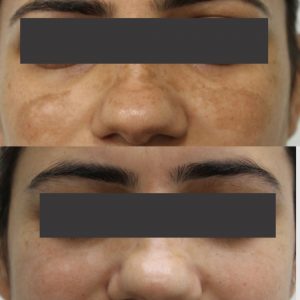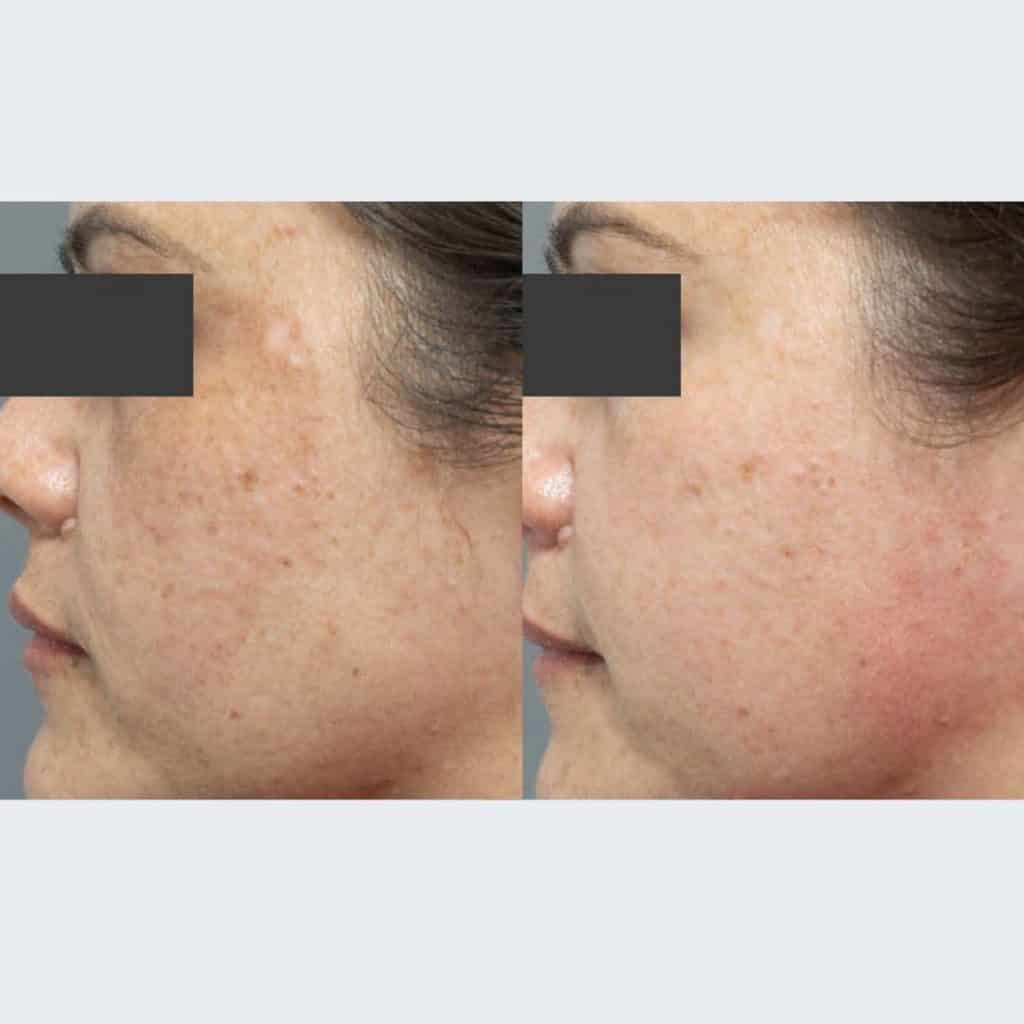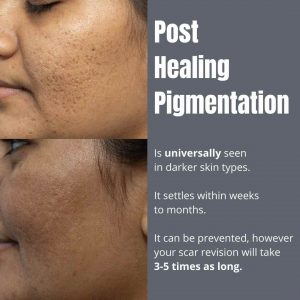Tranexamic Acid
| Best used: AM or PM | Caution:Coagulation issues orally | Best for: Melasma, pigment, post inflammatory pigmentation |
| Comments: Best taken orally. Topicals may have some effect | Mode of action: Vascular modulation of pigment | Science Score: ** Cream ***** Tablets
|
What is the skin science behind Tranexamic Acid?
Tranexamic acid provides a powerful and specific anti-inflammatory action, inhibiting pigment production in pigment cells known as melanocytes. At the same time it blocks the transfer of pigment from melanocytes to cells in the upper layers of skin. Tranexamic acid also calms the skin and helps restore the skin barrier.
Essentially T.Acid modulates blood flow via VEGF-1 & Plasminogen receptors that interact with melanocytes. Pigment production is far more complex than addressing the pigment cell, as research has shown that many other factors contribute to pigmentation, including the interplay of blood vessels, epidermal cells, basement membrane factors, as well as fibroblasts. The science of T.Acid is the biggest breakthrough in the management of melasma of the past decade. The most robust studies have involved oral administration of this compound with doses ranging from 250 to 1000mg daily.


Does tranexamic acid lighten skin?
In recent times, tranexamic acid (TA) is claimed to have whitening & brightening effects especially for hyperpigmentation including melasma. This ingredient is best combined with other pigment correctors & chemical peels.
It can be combined with pico lasers or Spectra lasers for faster lightening.

How often should I apply Tranexamic Acid?
Topical creams of this ingredient can be used up to twice a day. T.Acid can be combined with other topical pigment correctors including retinol, arbutin, azelaic acid, kojic acid, as well as ascorbic acid. In some cases I combine T.acid with Hydroquinone in a compounded formulation. T. Acid comes in a variety of vehicles including serums, creams & tablets. Always use a similar vehicle to mix, namely if you are using other pigment corrector creams, use a cream formulation of T.Acid.
As with layering any new formulation, always perform a test patch first, before full on application. You should gradually add new ingredients over a period of time to reduce the chances of skin irritation.
Note: T.acid has marginal effects topically. It is best taken orally.

SHOP Dermaceutic 21 Day Expert Care Lightening Kit
Do we microneedle tranexamic acid?
NO. For two really good reasons. Firstly (& most importantly), micro needling can break the skin’s basement membrane, leading to pigment drop out in the deeper dermal layer.
Secondly it is impractical. The channels are left open for 24-36 hours, hence optimal absorption is only with a very tiny window. You are wasting your money placing or microneedling t.acid.

View our Treatment Gallery
What is the correct way to apply pigment correctors to skin?
One word: PRECISION. Whether you are using Tranexamic Acid, Kojic Acid, Arbutin or Hydroquinone for pigment, you have got to be PRECISE. Why? Because if you apply to the surrounding skin, you’re gonna get fading of normal skin, hence you will ADD another colour to the picture. Apply your corrector of choice with the TIP of a cotton bud, only to the affected areas.
Application should be in the evening, 2-4 hours BEFORE bedtime. Why? Because if you apply just before going to sleep, chances are you are going to smudge a whole lot of product on your pillowcase, resulting in, you guessed it, blotchy areas all over your face. Be precise, this will ensure your application is even.
What are the side effects of Tranexamic Acid?
Although tranexamic acid is safe for most skin types, it’s always important to consult with a skin specialist before incorporating a new ingredient into your skin care routine. This topical is compatible with many other skin care ingredients, however it can be irritating to those with very sensitive skin. As with the addition of any new product, start slowly with application every second night, & increase as tolerated. If you have super sensitive skin, a test patch may be prudent.
There are no systemic side effects of topical creams, however if prescribed orally, your dermatologist will discuss the risk benefit ratio of this tablet. Rare side effects include GIT upset & importantly clotting issues.

This acid ranks as the third tier of melasma treatment, behind sunscreen & tyrosinase inhibitors.
What is the best way to treat pigmentation?
Melasma pigmentation is best treated with a combination of sun protection, topical pigment inhibitors including hydroquinone, kojic acid, ascorbic acid, azelaic acid, & botanicals along with low dose lasers. For more information, go to @101.Skin Instagram or review the many articles & before & afters on this website.

Can T. Acid be combined with other skin care actives?
Yes, in most cases Tranexamic Acid plays well with other actives including pigment correctors, vitamin B3/Niacinamide, Hyaluronic acid, tretinoin & many others.

How do I incorporate Tranexamic Acid in my daily skin care routine?
A sensible skin care routine that incorporates Tranexamic Acid goes something like this;
AM: Gentle cleanser, then antioxidants*, SPF, make up. (*Tocopherol, ferulic acid, ascorbic acid)
PM: Cleanser, actives such as Niacinamide, Hyaluronic Acid, Pigment correctors & T.Acid (*Refer to below)
*There are many sensible options to combine skin care ingredients with endless combinations.A sensible starting point is to use a good formulation of tranexamic acid every other night and gradually incorporate it into your routine. If in doubt, dilute the active with a moisturiser, & conduct a test patch. Be guided by your skin care expert.

** Most dermatologists including myself would opt for oral t.acid over topical, as the former is more potent, especially when treating melasma. Contraindications to oral use include a personal or family history of pro coagulopathy. Prescription is specialist only.
What other conditions can be treated with Tranexamic Acid?
Tranexamic acid (TXA) is a medication used to treat or prevent excessive blood loss from major trauma, postpartum bleeding, surgery, tooth removal, nosebleeds, and heavy menstruation. It is also used for hereditary angioedema. T.Acid has efficacy & safety data stretching back many decades. This molecule is best taken orally, followed by intradermal injections, and finally topical creams.
What is the dose of tranexamic acid?
Dosing starts at 500 mg orally daily, however it can escalate to 1500 mg daily as an off label treatment. Be guided by your physician.
Davin’s Pro Tip on Tranexamic Acid
This ingredient is probably the most beneficial compound for the treatment of melasma & post inflammatory hyperpigmentation.

There is a plethora of excellent studies demonstrating the efficacy of this acid, along with many decades of safety data. The flipside is that it works best as a tablet & not a topical, however I do suspect that over the next few years better topical formulations will appear. Be guided by your skin expert as to the addition of this pigment corrector into your skin care regimen.

